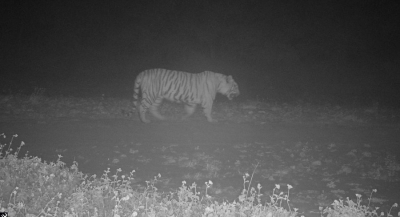Shimla: In a first, a camera trap captured an adult tiger sauntering in Himachal Pradesh, raising hopes of wildlife enthusiasts to see translocation of the big cat to a new home in the state’s 27.88-sq-km Simbalbara National Park, lying in the 810-km Terai Arc landscape, comprising the Shivalik Hills, between the river Yamuna in the west and the river Bhagmati in the east.
They believe tigers are making a new habitat in Simbalbara as the current one in neighbouring Uttarakhand gets crowded.
A wildlife expert favours reintroduction of more tigers in the western part of Rajaji National Park in Uttarakhand that could allow movement of tigers in the wider landscape comprising neighbouring states — Himachal Pradesh and Haryana — by restoring the original corridor in the Terai Arc Landscape to facilitate dispersal and the migration processes, which are critical to species persistence.
A state wildlife official told IANS there had been many oral narratives of tigers occasionally roaming forests of Simbalbara and Renuka, both in Sirmaur district, until this February when the first-ever picture of the tiger was captured. This photo could be the concrete base on which a detailed study on ecosystem and migration of tigers from Rajaji National Park in Uttarakhand to Himachal Pradesh could be undertaken, he said.
Also, the National Tiger Conservation Authority should reintroduce more tigers in the western part of Rajaji from the eastern landscape, he added.
The eastern side of the Rajaji Tiger Reserve has most of the tiger population, while the western side has just one-two tigers. The two sides are bifurcated by a national highway and a rail line.
Besides, the wildlife official plumps for including Simbalbara under the translocation of tigers project as the park supports dense Sal forests with grassy landscape and a healthy herbivore prey species base.
However, Uttarakhand foresters claim the tiger that was spotted in Simbalbara in February strayed from the Rajaji park and travelled over 120 km across in search of new territory by passing through several human habitations in less than three months.
Records say tigers and elephants are the sporadic visitors to the Simbalbara park in the Paonta Valley that lies in the Shivalik hills, adjacent to Haryana’s Kalesar National Park.
According to the Zoological Survey of India (ZSI), the Simbalbara National Park is the only conservation area in Himachal Pradesh where the occurrence of tiger and elephant has been reported.
In a faunal survey by the ZSI in 2005 and 2006, tiger pugmarks and scats were observed in two instances. One scat sample collected was composed of pure soil with abundant undigested ants, while another scat sample composed of digested bones in the form of powdery calcareous substance along with undigested hairs.
Although Simbalbara supports a good prey base for large carnivores, its smaller size is not suitable for a tiger to reside permanently, says the ZSI.
In November 2022, a herd of elephants was spotted in Simbalbara National Park, which is now renamed the Sher Jung National Park.
On the habitat of the elephants, the ZSI says since grass is the major food item for elephants, the smaller size and deciduous vegetation of Simbalbara, without much grassland, cannot sustain an elephant herd for a longer period. Hence the park is not an attractive habitat for the elephant.
On the tiger’s recent presence in Simbalbara, Divisional Forest Officer (Wildlife) N. Ravisankar told IANS the water flow in the Yamuna river is minimised during winter and there “is possibility that it reached up to Simbalbara from the Rajaji National Park”.
Simbalbara, originally the hunting ground for the Maharaja of Sirmaur, is home to the sambhar, spotted deer (cheetal), barking deer, wild boar, the blue bull and many other prey mammals.
About the movement of tigers, a wildlife expert told IANS that the Simbalbara and Kalesar national parks are connected, but not Rajaji.
In 2014, a watchman of the Renuka Lion Safari-cum-Mini Zoo near Simbalbara claimed to have spotted a tiger.
Also villagers settled in the periphery of the 402-hectare Renuka wildlife sanctuary reported the sighting of a tiger.
Subsequently, an extensive search in the 402-hectare Renuka wildlife sanctuary was carried out by the wildlife wing, but could not find any evidence of the tiger.
The Renuka sanctuary is also home to many flora and fauna species. The famous mammals found in the sanctuary are the leopard, jackal, jungle cat and various herbivores like barking and spotted deer, wild boar, hare and porcupine.
Wildlife experts say now the claim regarding the presence of a tiger in Simbalbara park is corroborated, the state should ask the central Environment Ministry to extend its tiger project from the Rajaji National Park to Simbalbara.
Previously, the Simbalbara National Park, the Kalesar National Park and the Rajaji National Park were well-connected tiger corridors.
(IANS)

















